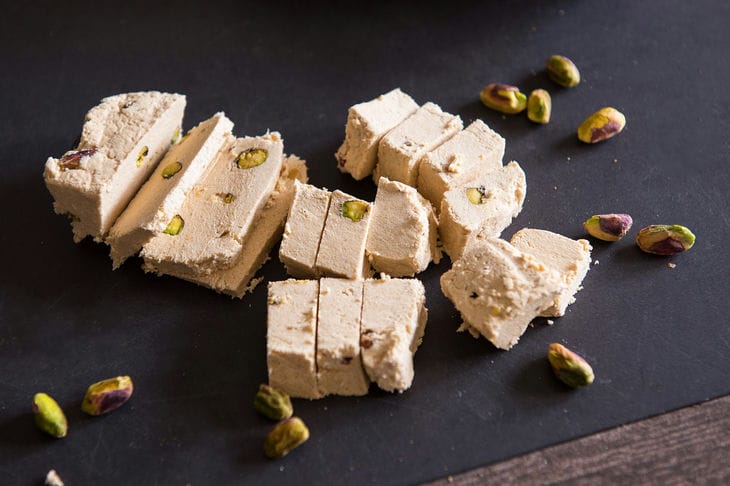How to Make Halva at Home: Secrets Revealed
The delicate and aromatic taste of halva captivates many lovers of sweets and makes halva an integral part of the traditional cuisine of many countries.
In addition, preparing halva yourself allows you to control all the ingredients and additives, which makes this delicious treat even more healthy and natural.
Making halva at home is a simple process that requires some skills and certain products, says Yulia Arkhipova .
History of Halva: From Ancient Times to the Present
The history of halva goes back to ancient times. This sweet dessert was known in Ancient Egypt and Babylon, where it was prepared from honey and nuts. In Asia, halva was also very popular and was considered a symbol of wealth and prosperity.
Over time, halva recipes have changed and adapted to different cultures. In India, it was made from tilda seeds (raw or roasted), and in Turkey, from sesame or sunflower seeds, with various spices added to give it a special flavor.

With the advent of sugar in Europe, the recipe for halva began to change: it became the main ingredient, replacing honey. The complexity of making halva decreased, but it still remains a popular dessert throughout the Middle East.
Nowadays, there are many varieties of halva - from classic to exotic. It can even be prepared at home using simple ingredients such as sugar, honey and nuts. The secret of good halva is in the right combination of ingredients and careful adherence to the recipe.
Basic ingredients and principles of making halva
To make halva at home, you will need only a few basic ingredients.
The base is made from sunflower or sesame seeds, which are fried in a pan until golden brown. Honey or sugar cane syrup is then added to add sweetness and texture.
It is important to remember the principles of cooking halva. The first rule is constant stirring. This is necessary for uniform heating and preventing the formation of lumps. The second rule is temperature control.
Halva is cooked over low heat to avoid burning and preserve its delicate taste.
It is also worth considering that halva can vary in texture and additives. For example, you can add chopped nuts or dried fruits to create interesting flavor combinations.
Following these simple instructions, you can easily prepare delicious and aromatic halva right at home. Don't forget to experiment with additives and enjoy the result!
Popular recipes for halva at home
One of the easiest and fastest ways to make halva is to use sesame, honey and sugar. To do this, fry the sesame in a dry frying pan until golden brown, add honey and sugar, mix all the ingredients until smooth.
Then the resulting mixture should be placed on a baking sheet or form, level the surface and leave until completely solidified. After this, the halva is ready to eat!
Another popular halva recipe includes pumpkin seeds, honey and nuts. To prepare this halva, fry pumpkin seeds in a frying pan without oil until they become fragrant, then add honey and nuts (you can use walnuts, almonds or pine nuts), mix thoroughly and place on a baking sheet or mold to harden. After cooling, the halva can be cut into pieces and served with tea or coffee.
Secrets of successful halva preparation: techniques and tips
The secrets to successfully making halva at home are to use certain techniques and follow recommendations. First, to get the delicate texture of halva, you need to properly prepare the ingredients.
It is better to use butter to make the dessert more aromatic and creamy. Secondly, when adding honey or sugar, remember that they will contribute to the thickening of the mass, so the liquid (water or milk) should be added carefully and gradually to achieve the desired consistency.
It is also important to consider the cooking time: the longer you cook the halva on low heat, the denser it will become. Do not forget about spices - to create a unique aroma, you can add cinnamon, cardamom or vanilla.
And the last secret is the correct storage of the finished halva. To avoid drying out or oxidation of the product, it should be stored in a tightly closed container in a cool and dry place. Following all these techniques and tips will help you prepare homemade halva that will not only be tasty, but also high-quality.
Interesting variations of halva and ways to improve it
One of them is adding nuts or dried fruits. You can use walnuts, almonds, pine nuts or raisins to give the halva extra flavor and texture. Just add them to the dough before baking or sprinkle them on top of the fresh halva.
Another interesting variation is chocolate halva. To make it, simply add cocoa powder or dark chocolate to the basic recipe. This will give the halva a rich chocolate flavor.
You can also enhance halva with various spices, such as cinnamon, cardamom or ginger. They will add new shades of aroma and spice to your sweet.
If you like to experiment with new flavors, try adding pieces of fruit such as apples, pears or oranges. This will give the halva a fresh and fruity taste.
In general, there are many options for improving halva. You can create various combinations of ingredients to get a unique and inimitable taste.
Previously, there were warnings about when not to eat pomegranate.
